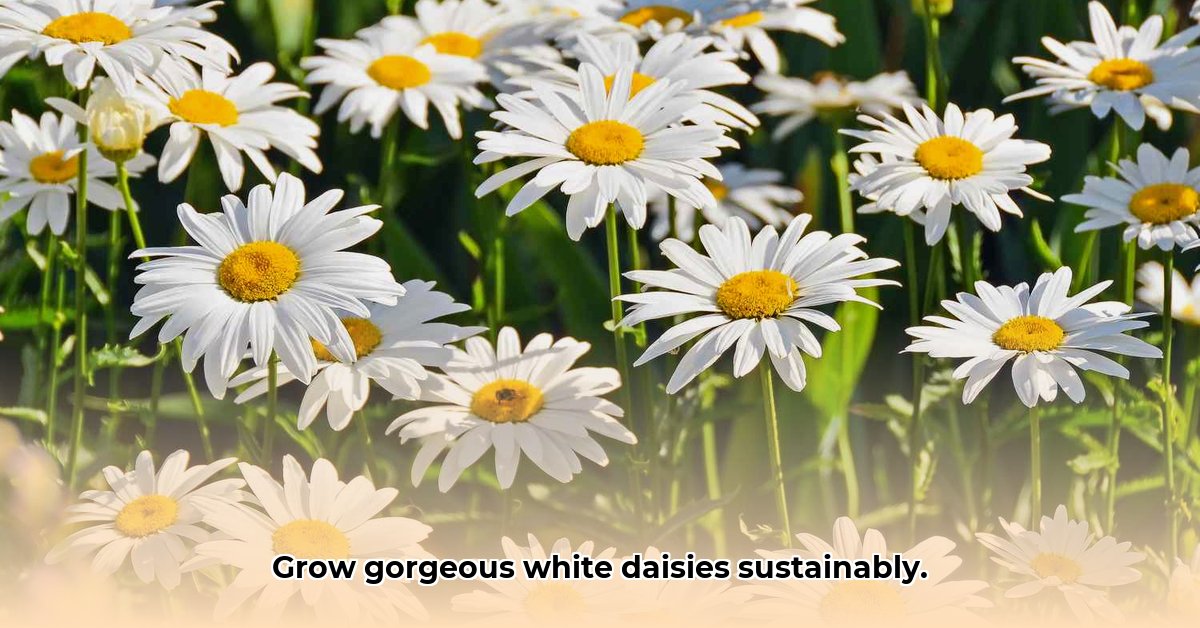Want a gorgeous, white daisy garden that’s also good for the planet? This guide shows you how! We’ll help you pick the perfect daisy varieties. Some daisies are super friendly to the environment, while others can get a little too enthusiastic and become invasive. You’ll learn easy, eco-friendly ways to plant, care for, and even propagate your daisies. Keep your garden blooming beautifully and sustainably for years. From soil preparation to natural pest control, and even how to manage daisies that might spread a bit too much. Let’s create a stunning, sustainable daisy paradise together!
White Daisies: A Sustainable Gardening Guide
Growing white daisies can be a wonderfully rewarding experience, especially when you do it in a way that’s kind to the environment. More and more gardeners are embracing sustainable practices, and white daisies are a perfect plant to showcase these methods. This guide will walk you through choosing the right daisies, planting them, and caring for them so they thrive while minimizing your impact on the planet. Discover eco-friendly tips and tricks for a blooming, sustainable garden.
Understanding Daisy Diversity
Daisies belong to the Asteraceae family, one of the largest plant families, encompassing a wide range of species with varied characteristics. Knowing these differences is essential for sustainable and responsible gardening.
Choosing the Right White Daisies: A Blooming Good Decision
Picking the perfect white daisy depends on your garden’s location, soil type and microclimate. Some daisies are well-behaved and happy to stay put, while others have a knack for spreading. Here’s a peek at some popular choices and their personalities:
| Daisy Species | Invasive Potential | Sunlight | Water Needs | Soil Type | Pollinator Magnet? | Bloom Time | Height (inches) | Notes |
|---|---|---|---|---|---|---|---|---|
| Shasta Daisy (Leucanthemum × superbum) | Low | Full sun | Moderate | Well-draining | Yes | Summer | 12-36 | Classic, reliable, big, beautiful blooms. Deadhead regularly. |
| Oxeye Daisy (Leucanthemum vulgare) | High | Full sun | Moderate | Well-draining | Moderate | Summer | 12-36 | Beautiful, but can quickly take over a garden. Monitor spread carefully. |
| English Daisy (Bellis perennis) | Moderate | Sun/Part Shade | Moderate | Well-draining | Moderate | Spring/Fall | 3-6 | Charming, adaptable, good for ground cover. Self-seeds readily. |
| Marguerite Daisy (Argyranthemum frutescens) | Low | Full sun | Moderate | Well-draining | Yes | Spring/Summer | 24-36 | Long blooming season, cheerful addition. Pinch back for bushier growth. |
| Montauk Daisy (Nipponanthemum nipponicum) | Low | Full sun | Low | Well-draining | Yes | Late Summer/Fall | 12-24 | Late bloomer, salt-tolerant, good for coastal gardens. |
| African Daisy (Osteospermum) | Low | Full sun | Low | Well-draining | Yes | Spring/Summer | 12-24 | Wide variety of colors and forms. Heat tolerant. |
| Painted Daisy (Tanacetum coccineum) | Moderate | Full sun / Part Shade | Moderate | Well-draining | Yes | Summer | 18-36 | Also known as Pyrethrum, known to attract butterflies. |
Important Note: The “invasive potential” is a general guideline. The actual behavior of a plant can differ based on your specific climate, soil conditions, and local ecosystem. What might be a well-behaved daisy in one area could become a bit of a troublemaker in another. Always observe your plants and manage them accordingly.
Before You Plant: Check with your local extension office or native plant society for recommendations on the best daisy varieties for your region. Also confirm if any are considered invasive in your area.
Cultivating Your White Daisies Sustainably: A Step-by-Step Guide
Let’s get those daisies in the ground! Here’s how to plant and care for them the sustainable way:
- Prepare the Soil: Healthy soil is the key to happy daisies. Before planting, amend your soil with compost and other organic matter. Compost is like a superfood for plants; it adds nutrients, improves drainage, and helps retain moisture. Aim for a slightly acidic to neutral pH (around 6.0-7.0). A soil test can help determine your soil’s pH and nutrient levels.
- Planting Time: Space your daisies appropriately, giving each one enough room to grow to its mature size. Check the plant tags for spacing recommendations. Overcrowding means competition for nutrients, water, and sunlight. Plant in early spring or fall. Dig a hole twice as wide as the root ball and just as deep. Gently loosen the roots before placing the plant in the hole.
- Watering Wisely: Water deeply but infrequently; let the soil dry out slightly between waterings. Once established, many daisies are quite drought-tolerant. Water at the base of the plant to avoid wetting the foliage, which can lead to fungal diseases. Use a soaker hose or drip irrigation for efficient watering.
- Feeding Your Friends (Organically): Skip the chemical fertilizers; they can harm beneficial insects, disrupt the soil microbiome and pollute the environment. Instead, use organic fertilizers, like compost tea, worm castings, or a balanced organic granular fertilizer. Apply fertilizer in early spring and again mid-summer, following package instructions.
- Pest Patrol (the Organic Way): Prevention is best. Healthy plants are less susceptible to pests and diseases. If problems arise, try organic pest control methods first. Encourage beneficial insects like ladybugs and lacewings, which prey on aphids and other pests. Insecticidal soap, neem oil, and diatomaceous earth are effective, environmentally friendly options for controlling pests. For fungal diseases, improve air circulation, avoid overhead watering, and apply a copper-based fungicide if necessary.
- Mulch Magic: Apply a 2-3 inch layer of organic mulch (like shredded leaves, straw, or wood chips) around your daisies. This helps conserve water, suppresses weeds, regulates soil temperature, and gradually enriches the soil as it decomposes. Keep mulch a few inches away from the plant stems to prevent rot.
- Deadheading Delight: Regular deadheading (removing spent blooms) encourages more flowers and prevents unwanted self-seeding. Cut the flower stem back to a leaf node or the base of the plant. Plus, your garden will look neat and tidy.
- Division is Key (for Longevity): Every couple of years, divide your daisy clumps in early spring or fall. This keeps them looking their best, prevents overcrowding, and gives you free plants to share with friends (or expand your own daisy patch!). Dig up the entire clump and gently separate it into smaller divisions, each with healthy roots and foliage. Replant the divisions at the appropriate spacing.
- Winter Wonderland (If Needed): In colder climates (zones 3-5), some daisy varieties might need a bit of winter protection. After the first frost, cut back the foliage to a few inches above the ground and apply a thick layer of mulch around the base of the plants. In very cold areas, you can also cover the plants with burlap or a frost blanket.
Long-Term Sustainable Practices: Building Your Daisy Ecosystem
Think of your daisy garden as a mini-ecosystem. The more you work with nature, the less you have to work against it.
- Composting: Compost kitchen scraps, yard waste, and even spent daisy flowers to create nutrient-rich soil amendments, reducing landfill waste. Build or buy a compost bin and follow proper composting techniques to ensure efficient decomposition.
- Integrated Pest Management (IPM): IPM involves using a combination of methods to prevent and control pests, focusing on natural solutions. This includes attracting beneficial insects, using resistant plant varieties, practicing good sanitation, and using chemical controls only as a last resort.
- Water Conservation: Collect rainwater in rain barrels to water your daisies. This reduces your reliance on municipal water and conserves a valuable resource. Install a drip irrigation system or soaker hose to deliver water directly to the plant roots, minimizing water waste.
- Attracting Pollinators: Plant other pollinator-friendly flowers near your daisies to attract bees, butterflies, and other beneficial insects. Choose a variety of flowers that bloom at different times of the year to provide a continuous source of nectar and pollen.
- Supporting Biodiversity: Encourage a variety of plants and animals in your garden to create a healthy, balanced ecosystem. Avoid using pesticides and herbicides, which can harm beneficial organisms. Provide habitat for wildlife, such as birdhouses, bee houses, and butterfly gardens.
- Sharing the Love (and Plants): Propagating and sharing your daisy plants (especially native varieties!) adds to your community’s biodiversity. It’s a wonderful way to extend the beauty of your garden and promote sustainable gardening practices.
Addressing Invasive Species: Responsible Gardening
Preventative measures are crucial. If you have daisies you don’t










